人教新目标中考英语复习-- 介词(共79张PPT)
文档属性
| 名称 | 人教新目标中考英语复习-- 介词(共79张PPT) |  | |
| 格式 | pptx | ||
| 文件大小 | 3.5MB | ||
| 资源类型 | 教案 | ||
| 版本资源 | 通用版 | ||
| 科目 | 英语 | ||
| 更新时间 | 2022-02-12 17:00:41 | ||
图片预览

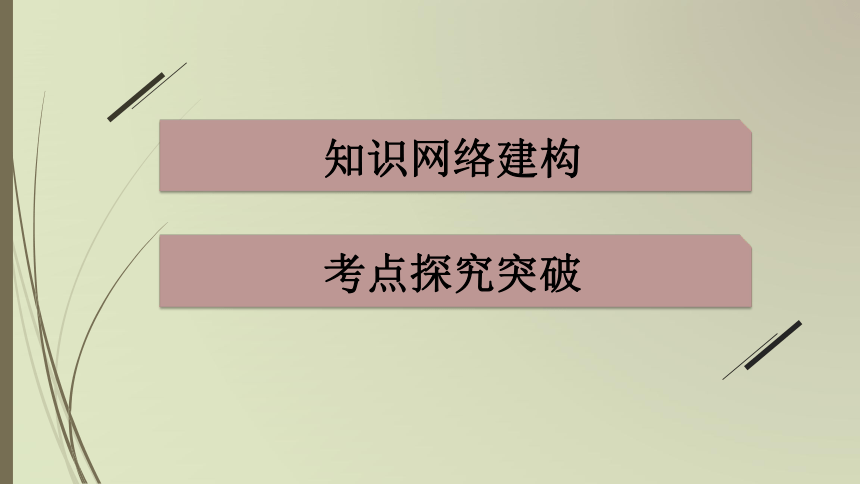

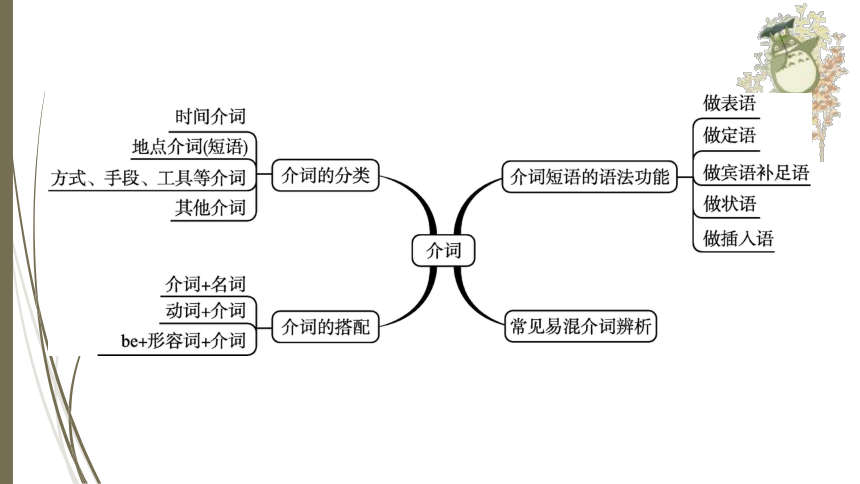
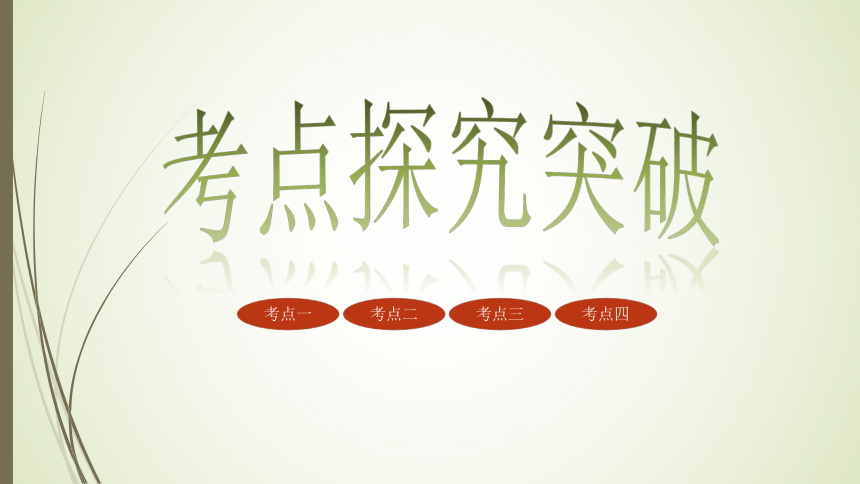
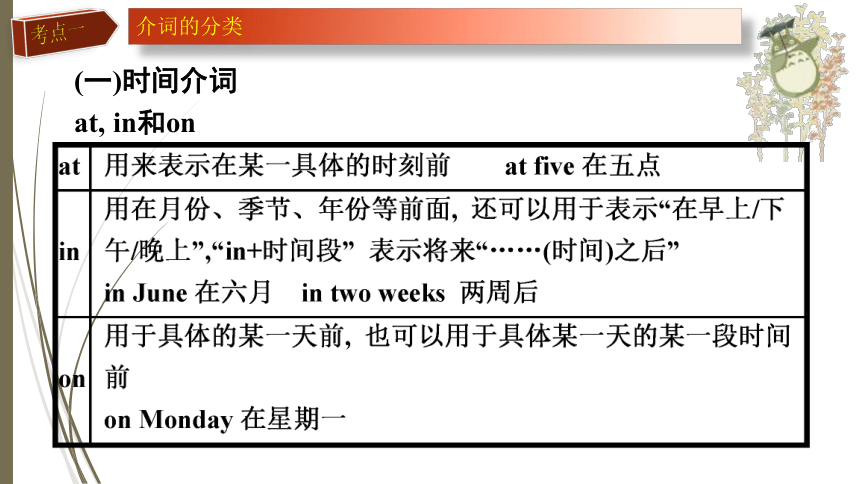
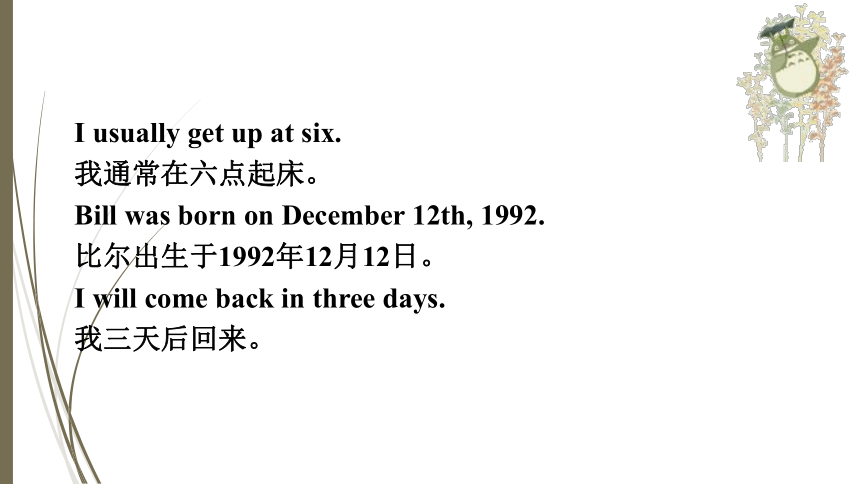
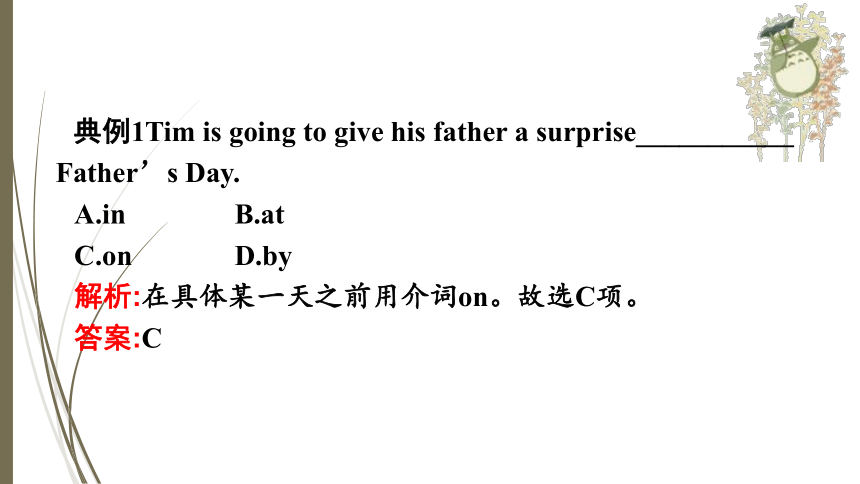
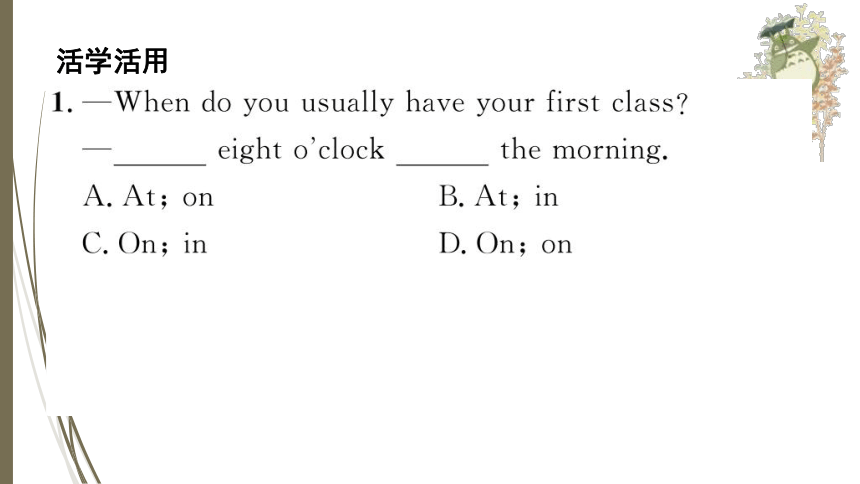
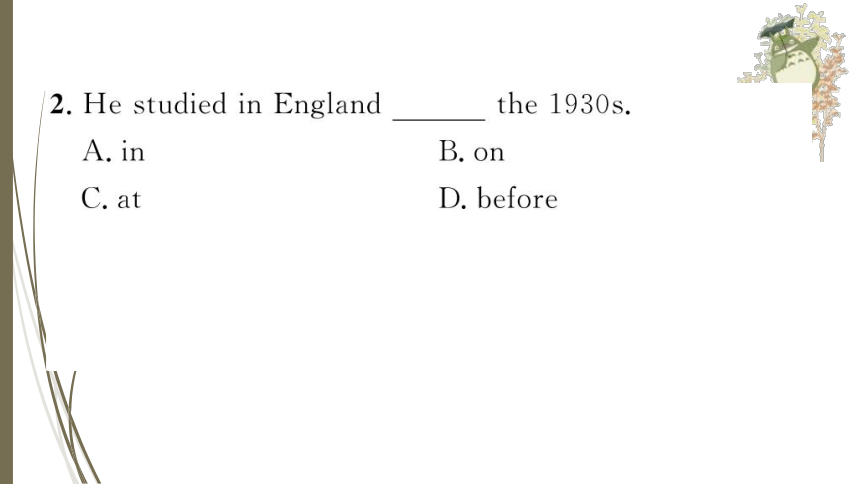
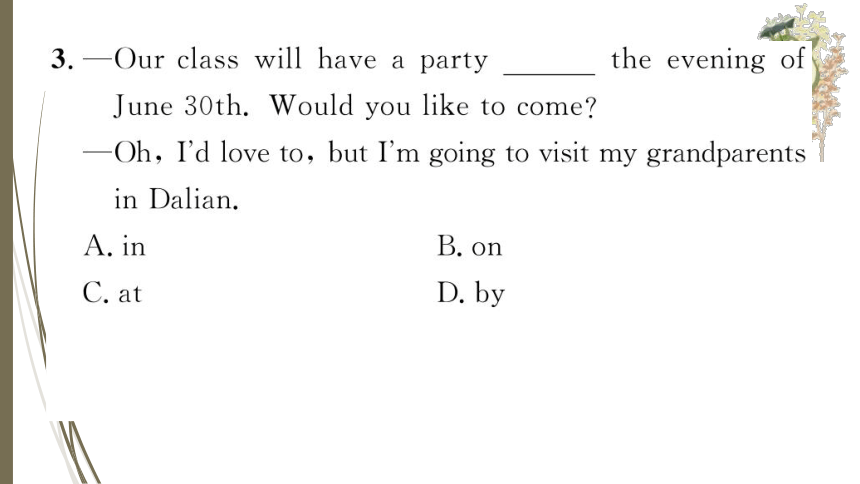
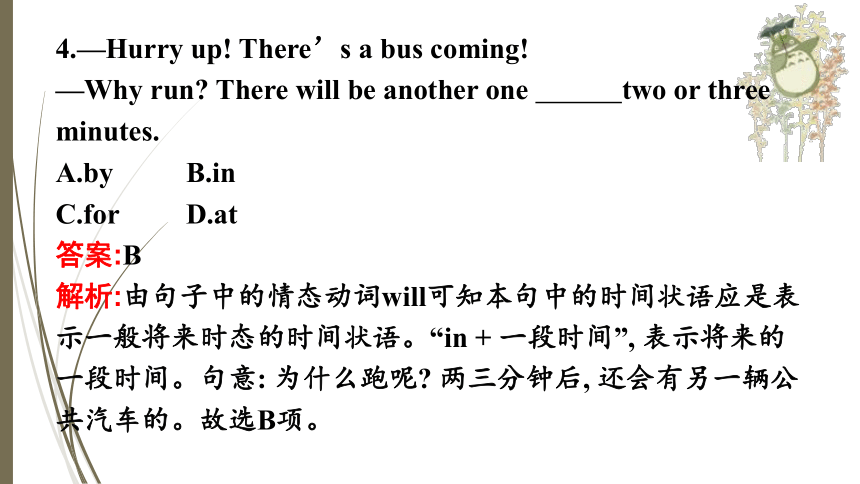
文档简介
(共79张PPT)
第一编 语法专项突破
第五讲 介词
知识网络建构
考点探究突破
知识网络建构
考点一
考点二
考点三
考点四
考点探究突破
考点一
介词的分类
(一)时间介词
at, in和on
I usually get up at six.
我通常在六点起床。
Bill was born on December 12th, 1992.
比尔出生于1992年12月12日。
I will come back in three days.
我三天后回来。
典例1Tim is going to give his father a surprise___________
Father’s Day.
A.in B.at
C.on D.by
解析:在具体某一天之前用介词on。故选C项。
答案:C
活学活用
4.—Hurry up! There’s a bus coming!
—Why run There will be another one two or three minutes.
A.by B.in
C.for D.at
答案:B
解析:由句子中的情态动词will可知本句中的时间状语应是表示一般将来时态的时间状语。“in + 一段时间”, 表示将来的一段时间。句意: 为什么跑呢 两三分钟后, 还会有另一辆公共汽车的。故选B项。
(二)地点介词(短语)
1.方位介词in, at, on和to
(1)in+较大地点; at+较小地点。如:
When did you arrive in Shanghai
你是什么时候到上海的
(2)包含在整体内部的用in, 接壤用on, 不相邻用to。如:
B is in the east of A.
C is on the east of A.
D is to the east of A.
Shandong is in the east of China.
山东在中国的东部。
Jiangxi is on the east of Hunan.
江西在湖南的东部。
Shanghai is to the east of Hubei. 上海在湖北的东部。
2.“上下” 介词on, above, over, below和under
(1)on“在……上面”, 表示两者接触。如:
The teacher put his textbook on the teacher’s desk.
老师把课本放在讲桌上。
(2)above“在……的上方”, 表示两者不接触, 其反义词为below“在……的下方”。
(3)over“在……正上方”, 表示两者不接触, 其反义词为under“在……正下方”。如:
We can build a bridge over the river.
我们可以在河上建一座桥。
My cat is lying under the chair.
我的猫正躺在椅子下面。
3.“前后” 介词in front of, in the front of和behind
There’s a playground in front of the library and a swimming pool behind it.
图书馆前面有个操场, 后面有个游泳池。
The boy likes to sit in the front of his father’s car.
那个男孩喜欢坐在他爸爸的车的前座上。
4.“左右” 介词短语on the left/right of,“旁边” 介词beside/by,“对面” 介词短语across from
Linda sits beside/by me, just on my left.
琳达坐在我旁边, 正好在我左边。
5.“里外” 介词in, inside, into, outside和out of
(1)in“在……内部”。如:
The pen is in my pencil case.
钢笔在我的铅笔盒里。
(2)inside“在……里面/到……里面”, 反义词outside“在……外面”。如:
We are asked to stay inside the building at work.
我们被要求待在楼里工作。
(3)into “到……内”, 其反义短语为out of。如:
Pour some milk into the blender.
把一些牛奶倒入搅拌机里。
典例2Paul’s mother is a nurse. She works a hospital.
A.with B.on
C.of D.in
解析:in a hospital“在医院里”。故选D项。
答案:D
活学活用
(三)方式、手段、工具等介词
典例3Class, let’s see who can spell the most words
these letters.
A.at B.into
C.on D.with
解析:句意: 同学们, 让我们看看谁能用这些字母拼写出最多的单词。with“用”。故选D项。
答案:D
活学活用
12.—How do you study for a test
— working with friends.
A.By B.With
C.On D.For
答案:A
解析:句意: ——你是怎么为考试做准备的 ——通过和朋友们一起学习。by“通过……方式”; with“和……在一起”; on“在……上面”; for“为了……”。故A项符合句意。
(四)其他介词
典例4Chinese will be widely used a foreign language around the world.
A.in B.for
C.as D.by
解析:be used as“被用作……”。故选C项。
答案:C
活学活用
考点二
介词的搭配
典例5Many wild animals are , and it’s time for us to do whatever we can to protect them.
A.on duty B.on show
C.in order D.in danger
解析:句意: 许多野生动物处在危险中, 到了我们做我们能做的来保护它们的时候了。in danger“处在危险中”。故选D项。
答案:D
活学活用
考点三
介词短语的语法功能
典例6—Do you remember what she looked like when you first met her
—Of course. She was tall and thin long hair.
A.in B.with
C.on D.at
解析:句意: ——你记得你第一次见到她时她的样子吗 ——当然。她又高又瘦, 留着一头长发。in“在……里”; with“具有”; on“在……上”; at“在……地点”。结合句意, 选B项。
答案:B
活学活用
考点四
常见易混介词辨析
1.between和among
between表示在两者之间; among表示在三者或三者以上之间。如:
The village lies between two mountains.
这个村庄位于两座山之间。
The village lies among mountains.
这个村庄位于群山之中。
典例7Sleeping is a popular way to relax students.
A.on B.among
C.about D.between
解析:among“在……中间”, 用于三者或三者以上。故选B项。
答案:B
活学活用
2.across, through和over
典例8—Excuse me, where is the bookstore
—Go the bridge. You’ll see it on your left.
A.on B.over
C.across D.through
解析:句意: ——打扰了, 书店在哪里 ——过了这座桥。你会在右边看到它。on“在……上面”; over“在……上方”; across“从一个平面上穿过”; through“在空间内穿过”。“过桥” 指从桥的一端到达另一端。故选C项。
答案:C
活学活用
3.except, besides和but
典例9—Alice, would you like to go hiking with us
—What a pity! I am free every day today.
A.for B.except
C.besides D.among
解析:由答语“真遗憾!” 可知“除了今天我每天都有空”。故用except。
答案:B
活学活用
4.since和for
典例10Our reading club shares ideas with each other
one hour every Tuesday.
A.to B.on
C.at D.for
解析:for后跟时间段。故选D项。
答案:D
活学活用
5.by, during和until
典例11They usually go shopping their lunch break.
A.against
B.among
C.between
D.during
解析:during意为“在……期间”; during their lunch break“在他们午休期间”。
答案:D
活学活用
不要为这个世界而惊叹,
要让这个世界为你而惊叹!
第一编 语法专项突破
第五讲 介词
知识网络建构
考点探究突破
知识网络建构
考点一
考点二
考点三
考点四
考点探究突破
考点一
介词的分类
(一)时间介词
at, in和on
I usually get up at six.
我通常在六点起床。
Bill was born on December 12th, 1992.
比尔出生于1992年12月12日。
I will come back in three days.
我三天后回来。
典例1Tim is going to give his father a surprise___________
Father’s Day.
A.in B.at
C.on D.by
解析:在具体某一天之前用介词on。故选C项。
答案:C
活学活用
4.—Hurry up! There’s a bus coming!
—Why run There will be another one two or three minutes.
A.by B.in
C.for D.at
答案:B
解析:由句子中的情态动词will可知本句中的时间状语应是表示一般将来时态的时间状语。“in + 一段时间”, 表示将来的一段时间。句意: 为什么跑呢 两三分钟后, 还会有另一辆公共汽车的。故选B项。
(二)地点介词(短语)
1.方位介词in, at, on和to
(1)in+较大地点; at+较小地点。如:
When did you arrive in Shanghai
你是什么时候到上海的
(2)包含在整体内部的用in, 接壤用on, 不相邻用to。如:
B is in the east of A.
C is on the east of A.
D is to the east of A.
Shandong is in the east of China.
山东在中国的东部。
Jiangxi is on the east of Hunan.
江西在湖南的东部。
Shanghai is to the east of Hubei. 上海在湖北的东部。
2.“上下” 介词on, above, over, below和under
(1)on“在……上面”, 表示两者接触。如:
The teacher put his textbook on the teacher’s desk.
老师把课本放在讲桌上。
(2)above“在……的上方”, 表示两者不接触, 其反义词为below“在……的下方”。
(3)over“在……正上方”, 表示两者不接触, 其反义词为under“在……正下方”。如:
We can build a bridge over the river.
我们可以在河上建一座桥。
My cat is lying under the chair.
我的猫正躺在椅子下面。
3.“前后” 介词in front of, in the front of和behind
There’s a playground in front of the library and a swimming pool behind it.
图书馆前面有个操场, 后面有个游泳池。
The boy likes to sit in the front of his father’s car.
那个男孩喜欢坐在他爸爸的车的前座上。
4.“左右” 介词短语on the left/right of,“旁边” 介词beside/by,“对面” 介词短语across from
Linda sits beside/by me, just on my left.
琳达坐在我旁边, 正好在我左边。
5.“里外” 介词in, inside, into, outside和out of
(1)in“在……内部”。如:
The pen is in my pencil case.
钢笔在我的铅笔盒里。
(2)inside“在……里面/到……里面”, 反义词outside“在……外面”。如:
We are asked to stay inside the building at work.
我们被要求待在楼里工作。
(3)into “到……内”, 其反义短语为out of。如:
Pour some milk into the blender.
把一些牛奶倒入搅拌机里。
典例2Paul’s mother is a nurse. She works a hospital.
A.with B.on
C.of D.in
解析:in a hospital“在医院里”。故选D项。
答案:D
活学活用
(三)方式、手段、工具等介词
典例3Class, let’s see who can spell the most words
these letters.
A.at B.into
C.on D.with
解析:句意: 同学们, 让我们看看谁能用这些字母拼写出最多的单词。with“用”。故选D项。
答案:D
活学活用
12.—How do you study for a test
— working with friends.
A.By B.With
C.On D.For
答案:A
解析:句意: ——你是怎么为考试做准备的 ——通过和朋友们一起学习。by“通过……方式”; with“和……在一起”; on“在……上面”; for“为了……”。故A项符合句意。
(四)其他介词
典例4Chinese will be widely used a foreign language around the world.
A.in B.for
C.as D.by
解析:be used as“被用作……”。故选C项。
答案:C
活学活用
考点二
介词的搭配
典例5Many wild animals are , and it’s time for us to do whatever we can to protect them.
A.on duty B.on show
C.in order D.in danger
解析:句意: 许多野生动物处在危险中, 到了我们做我们能做的来保护它们的时候了。in danger“处在危险中”。故选D项。
答案:D
活学活用
考点三
介词短语的语法功能
典例6—Do you remember what she looked like when you first met her
—Of course. She was tall and thin long hair.
A.in B.with
C.on D.at
解析:句意: ——你记得你第一次见到她时她的样子吗 ——当然。她又高又瘦, 留着一头长发。in“在……里”; with“具有”; on“在……上”; at“在……地点”。结合句意, 选B项。
答案:B
活学活用
考点四
常见易混介词辨析
1.between和among
between表示在两者之间; among表示在三者或三者以上之间。如:
The village lies between two mountains.
这个村庄位于两座山之间。
The village lies among mountains.
这个村庄位于群山之中。
典例7Sleeping is a popular way to relax students.
A.on B.among
C.about D.between
解析:among“在……中间”, 用于三者或三者以上。故选B项。
答案:B
活学活用
2.across, through和over
典例8—Excuse me, where is the bookstore
—Go the bridge. You’ll see it on your left.
A.on B.over
C.across D.through
解析:句意: ——打扰了, 书店在哪里 ——过了这座桥。你会在右边看到它。on“在……上面”; over“在……上方”; across“从一个平面上穿过”; through“在空间内穿过”。“过桥” 指从桥的一端到达另一端。故选C项。
答案:C
活学活用
3.except, besides和but
典例9—Alice, would you like to go hiking with us
—What a pity! I am free every day today.
A.for B.except
C.besides D.among
解析:由答语“真遗憾!” 可知“除了今天我每天都有空”。故用except。
答案:B
活学活用
4.since和for
典例10Our reading club shares ideas with each other
one hour every Tuesday.
A.to B.on
C.at D.for
解析:for后跟时间段。故选D项。
答案:D
活学活用
5.by, during和until
典例11They usually go shopping their lunch break.
A.against
B.among
C.between
D.during
解析:during意为“在……期间”; during their lunch break“在他们午休期间”。
答案:D
活学活用
不要为这个世界而惊叹,
要让这个世界为你而惊叹!
同课章节目录
- 词法
- 名词
- 动词和动词短语
- 动词语态
- 动词时态
- 助动词和情态动词
- 非谓语动词
- 冠词
- 代词
- 数词和量词
- 形容词副词及其比较等级
- 介词和介词短语
- 连词和感叹词
- 构词法
- 相似、相近词比较
- 句法
- 陈述句
- 一般疑问句和否定疑问句
- 特殊疑问句及选择疑问句
- 反意疑问句
- 存在句(There be句型)
- 宾语从句
- 定语从句
- 状语从句
- 主谓一致问题
- 简单句
- 并列句
- 复合句
- 主谓一致
- 主、表语从句
- 名词性从句
- 直接引语和间接引语
- 虚拟语气
- 感叹句
- 强调句
- 倒装句
- 祈使句
- 句子的成分
- 句子的分类
- 题型专区
- 单项选择部分
- 易错题
- 完形填空
- 阅读理解
- 词汇练习
- 听说训练
- 句型转换
- 补全对话
- 短文改错
- 翻译
- 书面表达
- 任务型阅读
- 语法填空
- 其他资料
